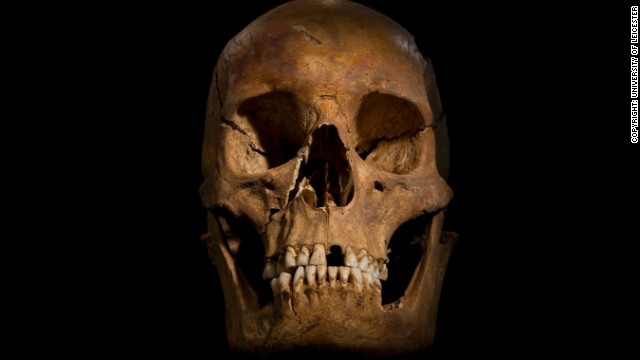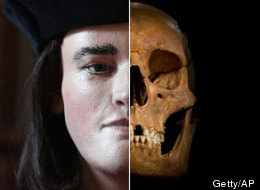News came out Monday morning, February 4 2012, that the skeleton found under the carpark in Leicester is in fact those of Richard III. After 6 months of waiting DNA test results came in late Sunday night with the news that, most of us pretty much expected, that Richard III had been found.
 |
| Richard III from the University of Leicester |
Looking at this photo gives me nothing but sympathy for King Richard III. Not only would have one shoulder been jacked-up to the sky because of scoliosis, but left untreated, and in his time that would have been the case, a hunchback, properly known as kyphosis. I imagine he must suffered terrible back pain plus difficulty in breathing because sever scoliosis can affect the lung capacity and the heart because in severe cases the ribcage would push hard against these organs and increasing the chances of pneumonia and heart failure. So with no treatment at that time in history for his affliction his life span was already shortened. Also,the spinal curve also stunted his growth because he would have been around 5'8" but was considerably shorter.
So because of this Richard III apparently lived life to is fullest, which did include him stealing the throne, but he wasn't the first to do so, and had his nephews, as children, declared illegitimate and thrown in the Tower of London where they died.Had former friends executed, but that is what happens when you lead an unsuccessful revolt against your king.
Before the children's death, however, Richard was a popular ruler, but when the boys died on his watch the popularity tide started to turn towards Henry, Earl of Richmond, who would become Henry VII, head of the rival house, the House of Lancaster and the first monarch of the House of Tudor. So in order to seize upon the momentum of popularity Henry Tudor landed in his birthplace of Pembrokeshire,Wales on his way to see to it that Richard III died at the Battle of Bosworth Field so he could claim the throne.
As is known this mission that Henry VI was successful in the battle for Richard III was killed on August 22, 1485 from one of two fatal injuries to the skull, according to a written statement from the University of Leicester. One of the wounds came from a sword and the other one came from a halberd, a two-handed pole weapon with what looks like an axe in it. "One was a "slice" removing a flap of bone" and "the other was caused by a bladed weapon which went through and hit the opposite side of the skull - a depth of more than 10 cm (4 ins)." In addition to these two wounds, there were six other wounds to the head were so violent that King Richard lost his helmet in battle . In addition to these wounds King Richard suffered"humiliation wounds" as well and it seems, luckily, that he suffered these wounds after he was killed. As if this kind of humiliation wasn't bad enough , he was stripped naked and laid over a horse to show the people of Leicester that Richard III was dead before being buried at Greyfriars Church in Leicester. This made Richard III the last king of England to be killed in battle.
After his burial at Greyfriars Church Henry VII had a marble and alabaster monument erected to Richard in 1495. According to a discredited tradition, during the Dissolution of Monasteries (when Henry VIII decided he wanted to be the religious ruler of England and all her lands at the time) Richard III's body was thrown into the River Soar, even though it has been suggested that the marble stone could still be seen as late as 1612, in a garden site of Greyfriars. But because of 400 years of development the burial site of Richard III and the garden were lost...until last year.
On August 24,2012 it was announced by the University of Leicester and the Leicester City Council in conjunction with the Richard III Society that they were going to begin looking for the king's remains. The experts from the University of Leicester Archeological services then set out not only to find the remains of Richard III, but also to find Greyfriars Church because it had been destroyed by Henry VIII's forces during the Dissolution of Monasteries. They compared fixed points on a map with historical sequence, the searchers located the foundation of Greyfriars Church on September 5, 2012 under a parking lot/car park. Two days later, on September 7, 2012, an announcement was made that skeletal remains had been found in the car park under what had been the area of the Church's choir. On September 12 it was announced that the skeleton might be that of Richard III.
 |
| The small black dot shows where Richard III was found. The pink outline is Greyfriars Church superimposed over a map of the modern area. |
So, a male descendant of Richard III's sister, Anne St. Leger, was found in Canada and a DNA swab was taken and then the world (to an extent) waited. The results finally came in late on Sunday night February 3, 2013 and it was then announced the following morning that the skeleton was indeed that of Richard III.
So now we have the long lost King Richard III of England. But what did he look like? We know this is what he looked like when he was found:
So now we have Richard III. May the truth good and bad be known about him.











No comments:
Post a Comment